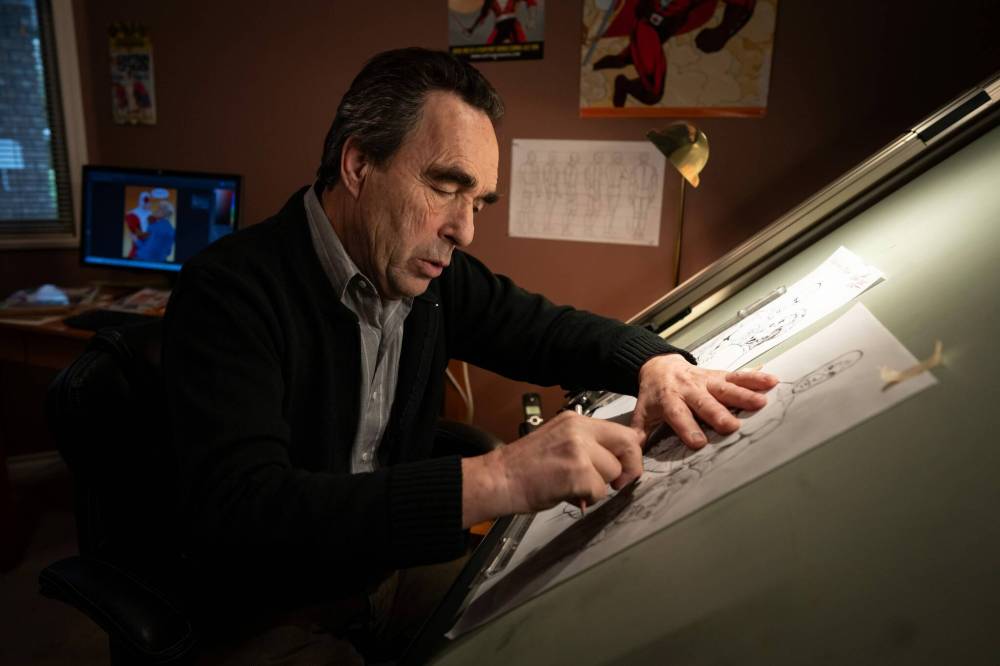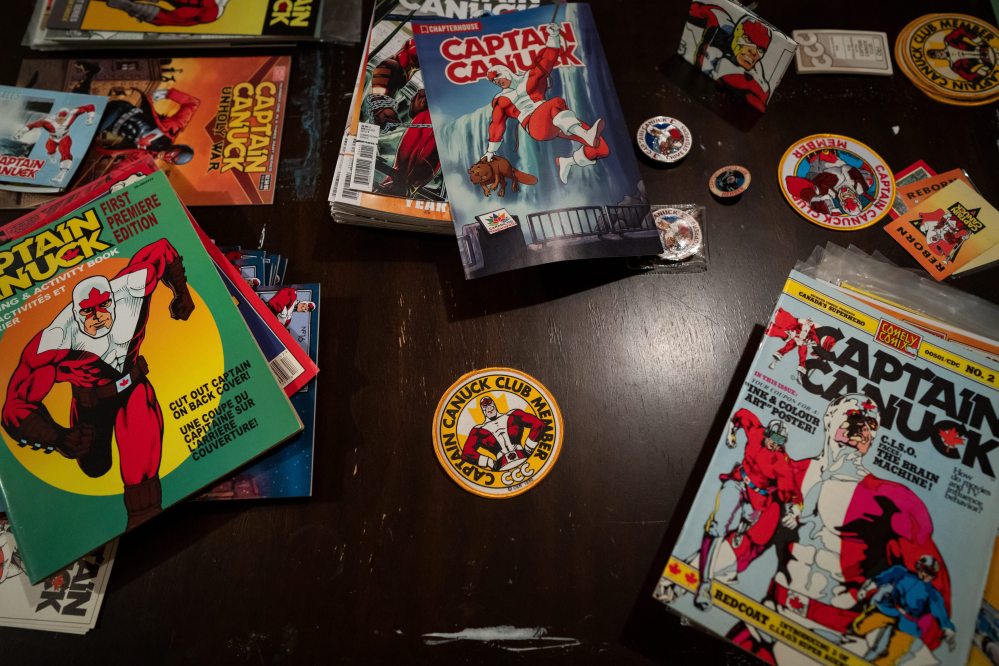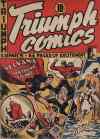A true Canadian flex In today’s tumultuous times, a virtuous, bilingual, red-and-white clad superhero comes to the country’s defence
Read this article for free:
or
Already have an account? Log in here »
To continue reading, please subscribe:
Monthly Digital Subscription
$0 for the first 4 weeks*
- Enjoy unlimited reading on winnipegfreepress.com
- Read the E-Edition, our digital replica newspaper
- Access News Break, our award-winning app
- Play interactive puzzles
*No charge for 4 weeks then price increases to the regular rate of $19.00 plus GST every four weeks. Offer available to new and qualified returning subscribers only. Cancel any time.
Monthly Digital Subscription
$4.75/week*
- Enjoy unlimited reading on winnipegfreepress.com
- Read the E-Edition, our digital replica newspaper
- Access News Break, our award-winning app
- Play interactive puzzles
*Billed as $19 plus GST every four weeks. Cancel any time.
To continue reading, please subscribe:
Add Free Press access to your Brandon Sun subscription for only an additional
$1 for the first 4 weeks*
*Your next subscription payment will increase by $1.00 and you will be charged $16.99 plus GST for four weeks. After four weeks, your payment will increase to $23.99 plus GST every four weeks.
Read unlimited articles for free today:
or
Already have an account? Log in here »
Hey there, time traveller!
This article was published 11/04/2025 (212 days ago), so information in it may no longer be current.
The bully got too close to Richard Comely’s drawing hand.
For the 22 students in the cramped one-room schoolhouse in Gainsborough District, just outside Portage la Prairie, there was hardly enough space for free expression on a regular afternoon.
Ahead of the Christmas pageant, the desks were squished together to make space for the stage, so Comely had to deal with an increasingly overbearing neighbour.
At every chance he got, the 17-year-old – two times Comely’s age and size – would tousle his hair and jab him in the ribs.
In an accent that revealed nothing of the smaller boy’s first two years of life spent in England, Comely would moan for help, shuffling his chair away in anticipation of the next smack.
The cycle repeated: the smaller boy would get poked, and when he responded, the teacher would divide the blame. In a classroom intended for first to fourth graders, the two boys normally had a single desk between them as a buffer.
Now, they lived next door.
So Comely buried his head in his math scribbler, where instead of doing long division he doodled, using creativity as a means of diplomatic pacificity. But despite the teacher’s tsk-tsking, the bully continued to taunt and grab.
“He had a habit of whacking your head down when you were trying to drink water from the tap,” recalls Comely.
For the larger boy, the threat of forthcoming punishment didn’t seem to have an effect, and before long, there was a trickle of blood.
The giant hand wasn’t invisible, and it was coming right at Comely’s face. Impulsively, he says, he reached up with his fountain pen and defensively jabbed at the back of the bully’s mitt.
“And you know, I broke the skin,” says Comely, 75, nearly seven decades later.
Richard Comely is the creator of Captain Canuck comics.
It was the only time Comely used his pen as a sword, but not the last time he seized on his instrument’s might.
By the time he was 24, he’d written, illustrated and published the first edition of his very own superhero, Captain Canuck.
Since making his debut in May 1975, Comely’s most famous character has starred on pyjamas, animated series and a national commemorative stamp while appearing in more than four million comic books in print worldwide.
Now, amid continuing trade scuffles with the United States, the bilingual special government agent, eco-warrior and Canadian defender is thriving as he approaches his 50th anniversary.
A certain brand of chest-thumping bully is both to blame and to thank.
After moving to Winnipeg to study advertising art at Red River Community College, Comely – who drew cartoons of classmates he liked (Ken Forkutza became the cannon-nosed Kent Bazooka) and posters for high school election candidates – needed paid work.
Create Your Own Super Hero
Richard Comely had never created a superhero until putting the finishing touches on Captain Canuck half a century ago.
At this time of international trade conflict, the Free Press invites artists to share their vision of a brand-new comic hero.
Mail your submission to Winnipeg Free Press, 1355 Mountain Ave., Winnipeg, Man., R2X 3B6, Attention: Ben Waldman, or email it to Ben for a chance to appear in the newspaper.
Include your name, your hero’s name and a brief superhero biography/origin story.
In October 1968, he responded to a wanted ad in the Free Press for crest design at Jay Dee Products, a firm with offices on the seventh floor of the Codville-Georgeson warehouse building on Westbrook Street alongside other garment district companies like Superior Sportswear and United Garments.
Joe Schachter, the chief of the shop, liked his drawings and hired the prim and proper Comely, who in keeping with his British heritage, always wore a necktie regardless of the occasion.
Comely worked 44 hours a week to earn a salary of $80, sitting in a windowless room while making custom crest designs for sports teams and youth groups.
“I recall designing a Blob Kicker crest for a group of guys who liked to kick the snow and ice blobs that accumulated behind car wheels in the winter,” he says.
Only once that he knew of did he design a crest for a motorcycle gang.
Though crest-making earned Comely a reasonable student’s income, he soon had motivation to make more than rent money: by 1972, a three-year marriage had ended and the 21-year-old artist found himself the single parent of two very young boys.
A convert to the Church of Jesus Christ of Latter Day Saints, Comely had made friends with a fellow parishioner named Ron Leishman, whose father, Ken, became known as the Flying Bandit after orchestrating the country’s largest gold heist in March of 1966.
Leishman, also an emerging cartoonist, floated to Comely the idea of developing a Canadian answer to Americanized superheroes.
“He put the idea in my head,” says Comely. “And then in 1973, I got serious about it.”
By the time Comely began developing the character who became Captain Canuck, Canadian comic-book shelves were indiscernible from their American counterparts, says Ivan Kocmarek, a comics historian from Hamilton.
But during the Second World War, conflict-based trade embargoes ushered in a brief “golden” era of comic creation north of the border.
Signed in 1940 and endorsed by Prime Minister William Lyon Mackenzie King, the War Exchange Conservation Act restricted the importation of non-essential goods from the United States, a list that included a number of items that were high on the wishlists of Canadian children: chocolate bars, candies and comic books.
Patriotic American titles like Captain America, who punched Hitler on his debut cover nine months before Pearl Harbor, were unavailable for purchase.
Lesser known characters like Captain Flag, whose sidekick was an eagle named Yank and whose arch-nemesis was the Black Hand, a name that indicated still-simmering sentiments held over from the First World War, were also stopped at the border.
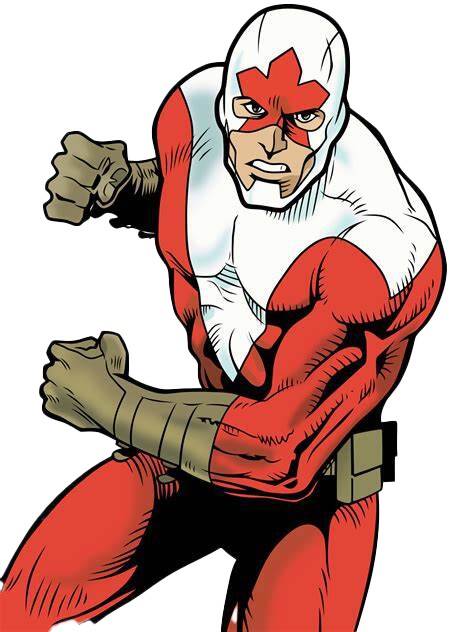
Even Superman — co-created in 1938 by Clevelander Jerry Siegel and the Toronto-born artist Joe Shuster — was deemed a foreign enemy on Canadian soil.
“When you get a war, you get nationalism,” says Kocmarek, who wrote Heroes of the Homefront, which focuses on the spate of Canadian wartime comic book characters like Nelvana of the Northern Lights — a pre-Wonder Woman hero co-created by Group of Seven artist Franz Johnston and Adrian Dingle — Johnny Canuck, Freelance and Canada Jack, who were created by defunct publishers like Maple Leaf, Anglo-American, Triumph and Hillborough Studios.
Supporting Canadian creations and heroes became a matter of national pride and the survival of a “Canadian” identity.
Once the embargo was lifted and the golden era of Canadian comics ended in the 1950s, Canadian publishers largely abandoned those nationalistic characters, opting instead to reprint the American comics domestic audiences had missed out on, says Doug Sulipa, the proprietor of Comic World, based in a jammed-to-the-rafters warehouse in Steinbach.
Those “Canadian editions” reflooded the North American marketplace with American titles that on the inside cover said “printed in the United States,” even though they were produced at presses in Quebec, says Sulipa. On the front cover were both American and Canadian prices.
During the reprint era, there was a vacuum of original Canadian comics, Kocmarek says, but throughout the 1960s “Canadian culture” began to assert itself: in 1965, the Canadian flag was adopted; in 1967, Canada marked its centennial and the world gathered in Montreal for Expo 67; in 1968, the CRTC was established; and soon thereafter, Canadian recording artists like Leonard Cohen, Joni Mitchell, Neil Young, Gordon Lightfoot and the Guess Who became household names in Minnesota, not just Manitoba.
Pages from the first edition of Captain Canuck.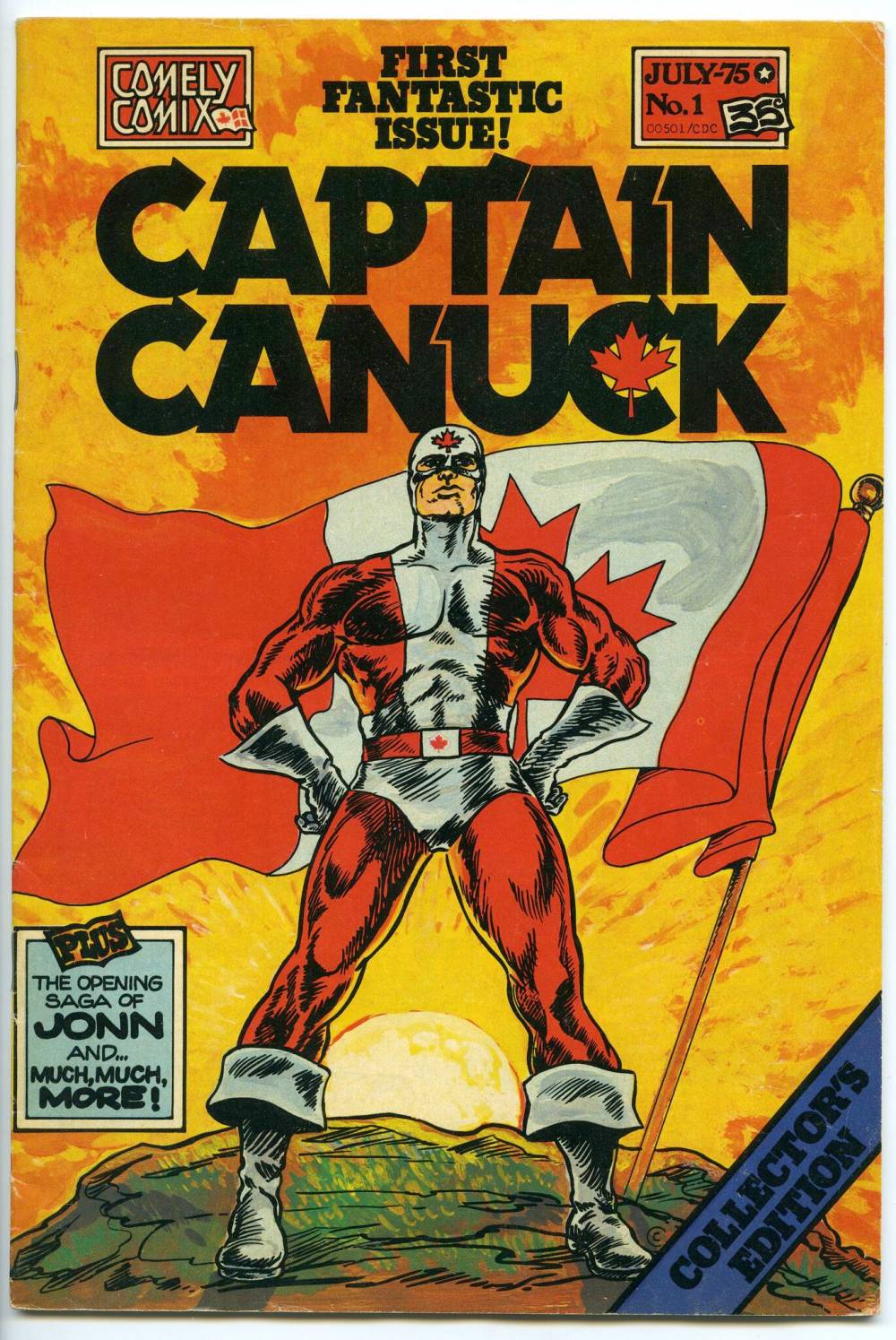
Elsewhere, the flamboyant, cosmopolitan Pierre Elliott Trudeau was living at 24 Sussex Dr., which brought a sense of unpredictable entertainment to Parliament Hill.
“To this point, the Canadian identity was sort of blah, nondescript, non-offensive and beige,” says Kocmarek, who points to the 1972 Summit Series pitting Canada’s hockey team against the Soviets as another breakaway point for patriotic passion.
Meanwhile, the FLQ and October Crisis in Quebec; the Vietnam War and associated student protest movements; the American Indian Movement and local Metis grassroots activism; plus U.S. president Richard Nixon’s ongoing impeachment troubles created an undeniable awareness of placehood and political stratification on either side of the line.
The timing, says Kocmarek, was ripe for a new wave of Canadian heroes to emerge. Across the country, comic book artists grabbed their pencils to capitalize on the patriotic surge.
It was a moment that set the stage for Captain Canuck, one of the most enduring independent comic book heroes in Canadian history.
In May 1973, Spider-Man crawled across the tyndall stone of the Winnipeg Art Gallery as part of The Structure of Comics, a landmark exhibition that placed Marvel Comics’ legends Stan Lee and John Romita in wings normally occupied by L.L. FitzGerald and A.Y. Jackson.
Developed by contemporary art curator Philip Fry and curatorial assistant Ted Poulos and featuring original artwork on loan from Marvel, The Structure of Comics drew thousands to the WAG.
“I toured this exhibit twice the other day with approximately 100 high-school students,” wrote Sturgeon Creek Regional Secondary School’s head of industrial design and graphic arts Gordon Grist in a memo to then gallery director Ferdinand Eckhardt. “They were disappointed when they had to leave.”
Also in the crowd was George Freeman, a 22-year-old graduate of Red River’s commercial art program who was working as an illustrator for Princess Auto’s catalogue. He was amazed by Romita’s original Spider-Man thumbnail art on view at the gallery.
In a Portage Avenue office, still designing crests, Comely was already hard at work developing the Canuck character as an independent publisher, dreaming up business plans for Comely Comix, which he envisioned as a company that gave readers “more for their money.”
Comely wasn’t a comic aficionado, but as an artist trying to support his family, he saw the potential for sustainability.
Richard Comely, at his drawing table in his studio in Abbotsford, B.C., still uses his pen as a sword.
Leishman had left the city for France on a mission with the church, but he, along with Comely’s parents, who ran a farm in Portage, were early investors.
Comely’s younger brothers were also briefly involved in the business during its planning stages, but most of the work was done by Comely and his friend Dave Abbott, who provided advice for media and advertising.
Comely also had met his future wife, Evelyn, who would go on to manage the Captain’s Toronto Star delivery business among dozens of other administrative duties.
By 1974, Comely had early cover sketches in his portfolio, and seeking an expert opinion, he went to Comic World, which was run by a 17-year-old Doug Sulipa in a third-floor studio on Carlton Street.
Sulipa was mildly unimpressed by the message of the cover, which depicted Captain Canuck, the alter-ego of Tom Evans, being gently mocked on the sidewalk by pedestrians who didn’t recognize him.
“I said, ‘That’s not going to make this thing popular,’” recalls Sulipa, who recommended a more prideful posture.
Comely nodded, went back to his drawing board, and returned with an image that would launch Captain Canuck into the national comic conversation.
“He’s got muscles like Superman and a Maple Leaf on his head,” declared Free Press staff writer Alan Christie.
“He’s God-loving, God-fearing. He’s dressed in white and red.”
Comely is planning a national comic convention tour.Set in the distant future of 1993, with Canada threatened by encroaching foreign forces, Captain Canuck’s first issue was launched in May 1975 with an initial run of 220,000 printed at Stovel Printing on Bannatyne.
Pages from the first edition of Captain Canuck. 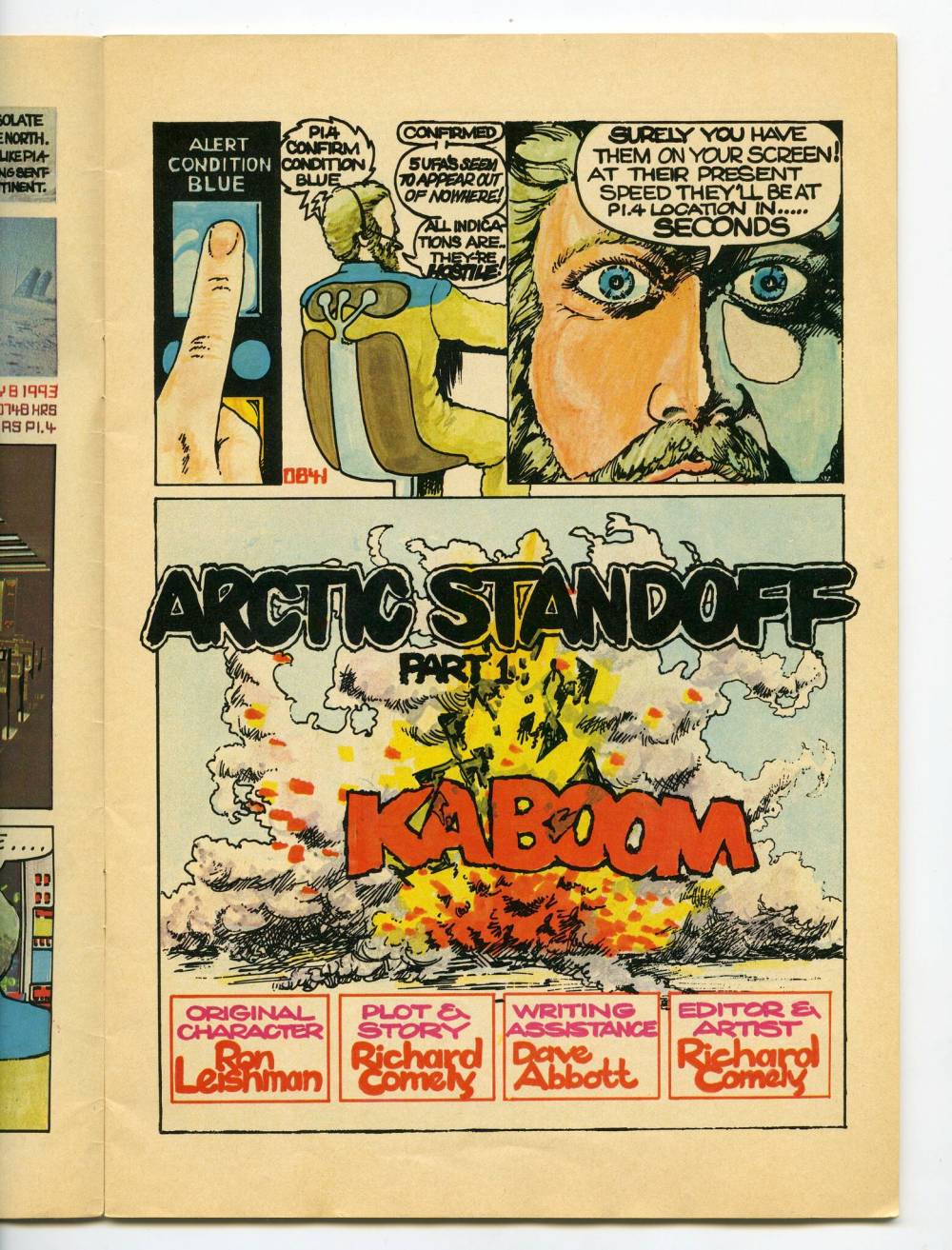
A hero who gains his speed and strength through alien contact, Captain Canuck’s Tom Evans is a special agent for the Canadian International Security Organization.
Known to exercise restraint and to only use violence when absolutely necessary, Captain Canuck is bilingual, polite, and though Comely didn’t use the word at the time, Tom Evans is canonically Métis.
“I felt it was important he had native blood in his veins,” says Comely.
As one of the first independently made comics in the country since the golden age, Captain Canuck generated considerable media attention, including a segment on CBC’s national news broadcast.
“A few miles from the heart of downtown Winnipeg in an obscure office on Portage Avenue, you’ll find the saviour of the Dominion,” a black-haired Lloyd Robertson told CBC viewers.
“Behind this door, you enter the domain of Comely Comix and the world of Captain Canuck… a tough-minded idealist who works for an outfit called the Canadian International Security Organization. Roughly, he’s a mixture of Sergeant Preston of the Yukon and a CIA agent.
“With cunning, but clean tricks, Captain Canuck’s mission in life is to save our natural resources from dastardly bad guys who’d like to destroy all our beaver dams, cut down all the maple trees, even turn out the northern lights. But Canuck is always there to save the day.
Pages from the first edition of Captain Canuck.
“His successful career is due to his ability to combine virtue, French, physical fitness, courtesy, the metric system and a form-fitting costume into a real hero role,” Robertson continued.
“He also has Richard Comely to thank … his mission in life is to fight the avalanche of American comics that’s infiltrating the Canadian market, and like his colour-comic counterpart, Richard is very successful.”
George Freeman took notice, and in July 1975 rushed to Comely’s office to show him his portfolio of Romita-style thumbnails. “My goodness, he was good,” says Comely of Freeman, who went on to draw for Marvel and to illustrate Batman Annual 11, written by Alan Moore.
Freeman, who still lives in Winnipeg, says there was a distinct energy at the time to the Manitoba capital, which had just celebrated its centennial and launched cultural events like the Winnipeg Folk Festival and Folklorama.
“It was a very positive place, and this whole Captain Canuck thing was a part of that.”
Pages from the first edition of Captain Canuck.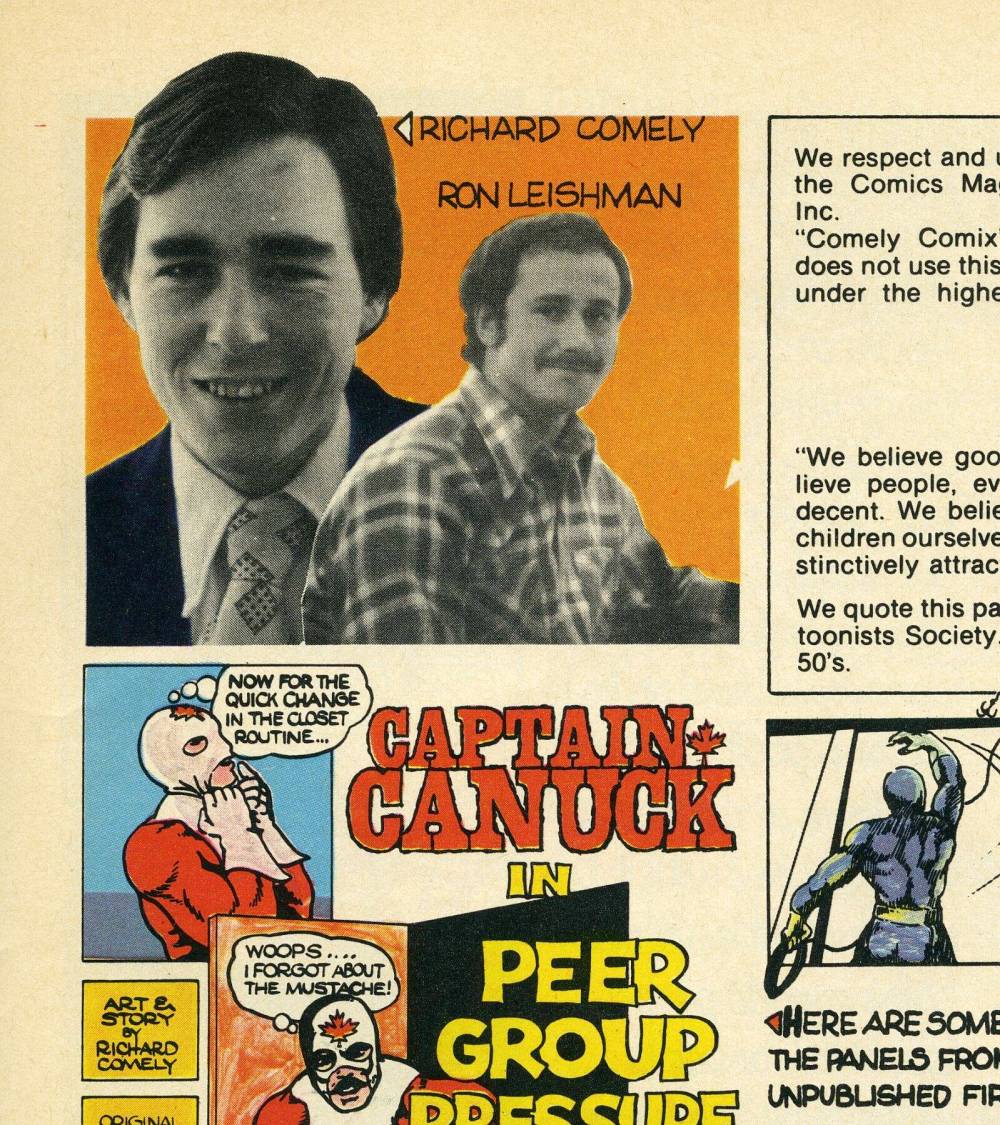
Freeman was hired a few days later, and the newest Comely Comix employee was impressed by Comely’s enthusiasm, which sometimes outweighed his business acumen.
“He’s a great salesman, and he was able to sell his product and his dream because he believed in that dream and he believed in that product. It wasn’t just because he invented the character with Ron Leishman, it was because he believed in him,” says Freeman.
By the third issue, the final one to be printed in Winnipeg, Comely and Freeman were joined by a bearded French Canadian travelling the country in search of work.
A graduate of the CEGEP du Vieux Montréal, Claude St. Aubin decided to give Comely an unannounced visit: when Comely got home from work he found Aubin playing catch with his younger brother.
In broken English, as he reached out his hand to introduce himself, he asked if he could help with “deh comic book.”
“Claude was clearly the best artist in the company,” says Freeman, who invited St. Aubin to live with him at his St. John’s neighbourhood apartment. “He learned English watching Monty Python on my TV.”
For the third issue, Freeman says the trio frequently put in 20-hour work days.
But despite the relative success of the comic, the men were not making a livable income, and by 1976, after the fourth issue was published, Comely ran out of money. He received an offer to run a weekly newspaper in Cardston, Alta., home to one of the largest Latter Day Saints communities in North America.
The employees of Comely Comix followed him, before five months later decamping for Calgary, where each of them worked on Canuck newspaper supplements and special features while also taking on other commercial gigs.
Pages from the first edition of Captain Canuck.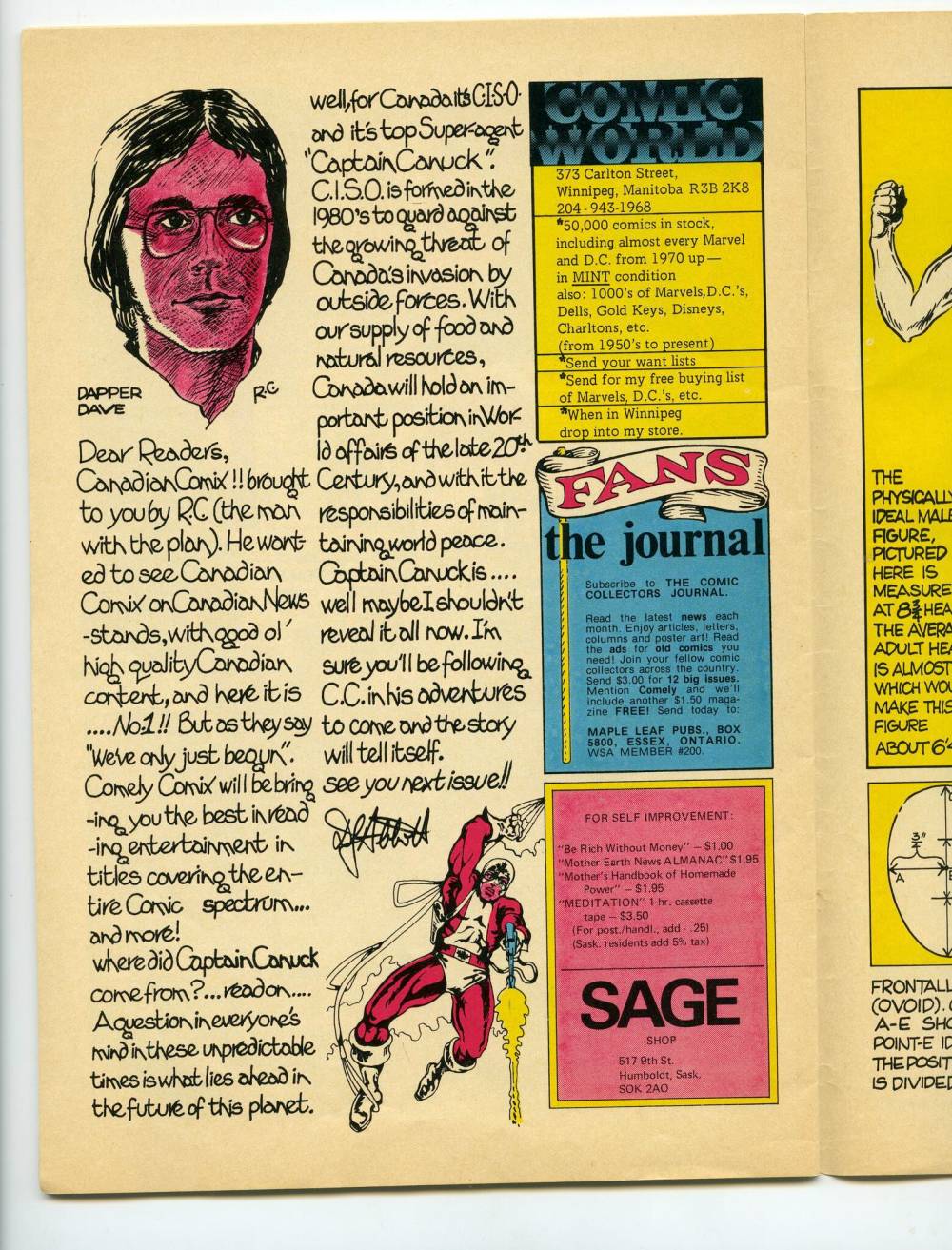
By 1980, they’d rounded up more funding, and with its 15th issue, Captain Canuck became the first Canadian comic ever to get nationwide distribution in the United States, according to contemporary coverage in Maclean’s.
In 1993, Comely returned to England to visit the battlefields where his grandfather, also named Richard Basil Comely, had fought as a captain in the First World War.
That year — the one the original series was based in — also saw the publication of the Captain Canuck Reborn series.
But for many years, the artist mostly focused his energy elsewhere, taking some corporate illustration and design gigs to make ends meet. But the captain never went away.
In 2004, Manitoban brothers Riel and Drue Langlois rebooted the character in Captain Canuck: Unholy War. And a few years later, the persona got a new lease on life, all thanks to a peameal bacon sandwich.
“I remember going to the flea market and I saw Captain Canuck No. 1,” says Fadi Hakim, an entrepreneur who bought the book for a dollar in 1979.
“I still have it. It’s not in tatters, but it’s probably not worth anything to anybody except for me.”
Now the chief executive of the publishing house Lev Gleason — a company named for an American comic-book publisher founded in 1939 known for its crime comics — and its subsidiary Chapterhouse, Hakim’s main line of business in his hometown of Toronto had historically been in the hospitality sector.
At 24, he became a partner in a pool hall called the Coloured Stone, known to draw patrons like Tom Cruise, R.E.M. and the Rolling Stones.
Other bar and restaurant ventures followed and in 2008, he and a business partner bought the 76-year-old historic diner, the Lakeview Restaurant, on Dundas Street West in Toronto.
When it came time to name the restaurant’s peameal bacon sandwich, he felt compelled to choose The Captain Canuck, and so he called Comely, who agreed to provide the name and to put an illustration of the character on the kids’ menu.
“I asked him what was happening with the character,” recalls Hakim. “He fell off the face of the Earth.”
In 2004, Captain Canuck got a reboot and a new lease on life.As it turned out, the licence was set to expire, and Hakim jumped at the chance to take it over. Soon, Captain Canuck was the centrepiece of the comic roster at Chapterhouse, which in 2017 attracted Canadian actor Jay Baruchel as an investor and chief creative officer.
“This was the kind of thing we’d talk and dream about as Canadian kids — a homegrown Canadian extended comic book universe,” Baruchel told CBC at the time. “This was both an adventure and holy mission, and one I knew I had to be a part of.”
With Kalman Andrasofszky, Baruchel co-wrote Captain Canuck: Year One, set against the backdrop of the war in Afghanistan. (Baruchel left the company shortly after, leaving plans for a motion picture adaptation behind.)
Since moving to Chapterhouse, Captain Canuck has appeared in nearly 20 new comic editions, many illustrated by Freeman. The hero was also the star of an animated web series produced in the 2010s, featuring actors like Tatiana Maslany.
Hakim has also brought into the company’s fold other Canadian heroes including Freelance, Fantoma and Northguard.
But for Hakim, a card-carrying member of the Captain Canuck fan club, one hero does stand above the rest.
Ahead of his 50th birthday, Captain Canuck is enjoying nearly as much publicity as he received upon his national debut, thanks in large part to a new anniversary cover where the hero wags his finger at American President Donald Trump.
On Comely’s drawing table in Abbotsford are early sketches of the Captain grabbing both Trump and billionaire consigliere Elon Musk by the scruffs of their necks.
Only when discussing Trump does the mild-mannered Comely — who’s never tolerated bullies — become animated.
“I think with Trump, there are probably some mental health issues with him,” he says. “He’s a scary, scary guy, and the fact that the country put him in power is a pretty poor reflection on the whole country in my opinion.
Captain Canuck is enjoying renewed publicity with a new anniversary cover where the hero wags his finger at American President Donald Trump.“Most of our media, our entertainment, comes from the United States, and whatever TV shows and movies are created in Canada often mirror what we see Americans produce,” continues Comely, who fears a rising tide of fascism.
“It’s really disappointing that they have a president generating a lot of unnecessary animosity between two countries, and people say they’re negotiation tactics. Well, they’re terrible tactics.”
Comely, who is planning a national comic convention tour, including a stop in Winnipeg this summer, to mark the captain’s 50th anniversary, says Trump’s threats of annexation have led to more enthusiasm for his comic and for his country in general.
“I think those comments are unifying Canadians,” he adds. “We’re looking at each other and saying, ‘We’ve got to stick together here.’”
In Winnipeg, the new Trump cover and the president’s comments have generated some renewed interest in Captain Canuck as an expression of international displeasure.
An East Kildonan comic book seller says he recently sold a copy of Captain Canuck No. 1 to a customer who “came in because, in his words, his brother is an idiot American Trump supporter, and he wanted to send it to him as an ‘F You’ for his birthday.”
As it turns out, not all heroes wear capes.
ben.waldman@winnipegfreepress.com
More Canuck comics
Interested in learning more about Canadian comics? Check out these resources:
● Canadian Literature: The Pasts, Presents, and Futures of Canadian Comics, guest edited by U of W English professor Candida Rifkind, who specializes in alternative comics and graphic narratives
● Sequential Magazine’s Special Eighth Issue
● Comicbookdaily.com’s Comics From the Great White North
● Guardians of the North by archivist and historian John Bell
● Invaders from the North by John Bell (available from Dundurn Press)
● Radio Free Krypton, a podcast about Canadian comics (available to stream)
● The Doug Wright Awards for Canadian comics and cartoons
● The Prairie Comics Festival (@prairiecomicsfestival)
Other Manitoban stories
With the help of Free Press reviewer and comics writer Nyala Ali, we rounded up a selection of contemporary comics and graphic storytelling projects by Manitobans.
On May 27, Ali and Lisa Mendis will release Curb Angels 2, published by local house At Bay Press.
1. Between the Pipes by Albert McLeod, with Elaine Mordoch, Sonya Ballantyne and Alice RL (Highwater Press)
2. Christie Pits by Jamie Michaels and Doug Fedrau (Dirty Water Comics)
3. Comrad Comics: The Winnipeg Comic Anthology (@comradcomics)
4. I Used To Be a Magical Girl by Saka (sakasketches.com)
5. Hologram Hunter by Scott A. Ford (scottaford.storenvy.com)
6. American Youth by Nicholas Friesen (nicholastronaut.bigcartel.com)
7. Hero-Man by Zach Schuster and Lyndon Radchenka (At Bay Press)
8. Krampus is my Boyfriend by S.M. Beiko (smbeiko.com)
9. Reckoner trilogy by David A. Robertson and Scott Henderson (Portage and Main Press)
10. Watchitu by Eric Hetherington (mcduckillustration.gumroad.com)
11. Shelterbelts by Jonathan Dyck (Conundrum Press)
12. This Place – 150 Years Retold (Portage and Main Press)
13. Politikids by Kaj Hasselriis (kajhasselriis.weebly.com)
If you value coverage of Manitoba’s arts scene, help us do more.
Your contribution of $10, $25 or more will allow the Free Press to deepen our reporting on theatre, dance, music and galleries while also ensuring the broadest possible audience can access our arts journalism.
BECOME AN ARTS JOURNALISM SUPPORTER
Click here to learn more about the project.

Ben Waldman is a National Newspaper Award-nominated reporter on the Arts & Life desk at the Free Press. Born and raised in Winnipeg, Ben completed three internships with the Free Press while earning his degree at Ryerson University’s (now Toronto Metropolitan University’s) School of Journalism before joining the newsroom full-time in 2019. Read more about Ben.
Every piece of reporting Ben produces is reviewed by an editing team before it is posted online or published in print — part of the Free Press‘s tradition, since 1872, of producing reliable independent journalism. Read more about Free Press’s history and mandate, and learn how our newsroom operates.
Our newsroom depends on a growing audience of readers to power our journalism. If you are not a paid reader, please consider becoming a subscriber.
Our newsroom depends on its audience of readers to power our journalism. Thank you for your support.
History
Updated on Friday, April 11, 2025 6:42 AM CDT: Corrects typo
Updated on Friday, April 11, 2025 9:51 PM CDT: Fixes typos



